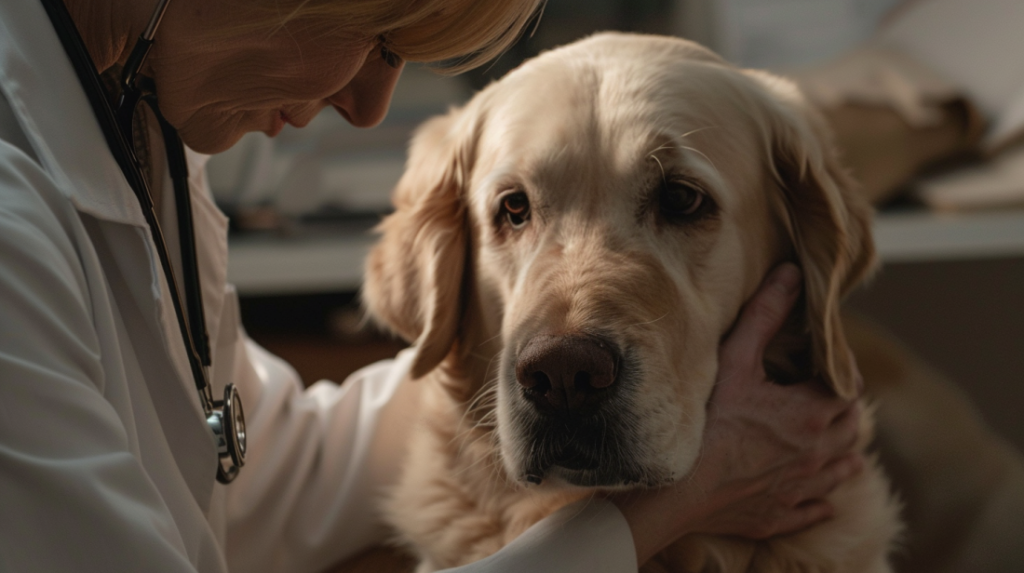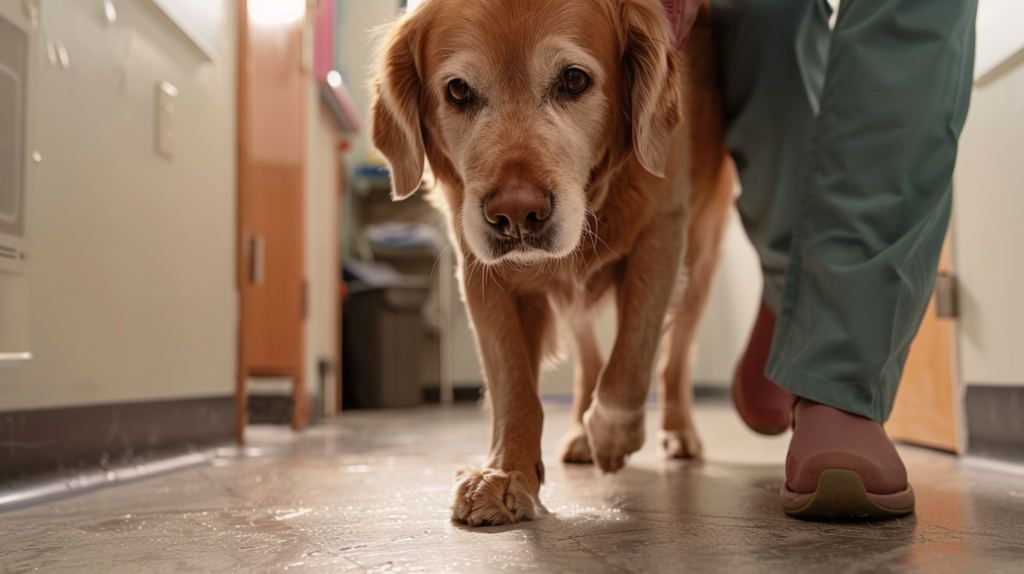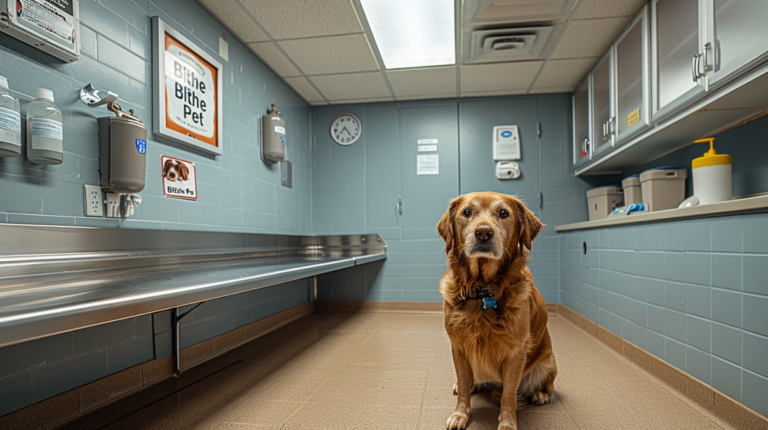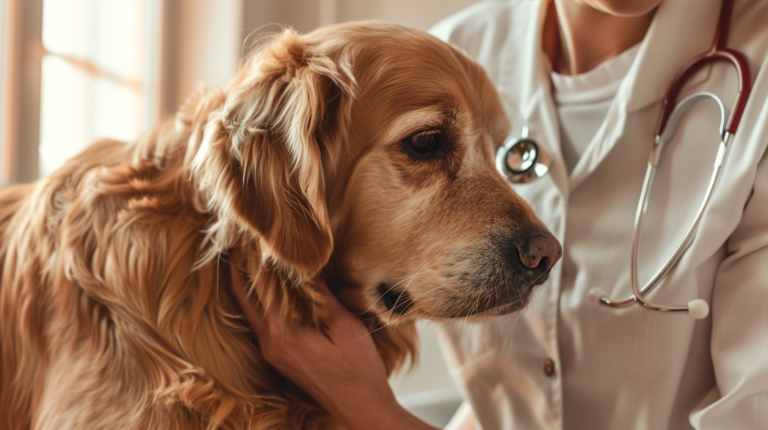Discover 7 alarming causes of blood in dog stool. Learn symptoms, treatments, and when to see a vet. Essential guide for responsible pet owners seeking immediate answers.
Table of Contents
Finding blood in your dog’s stool can be one of the most frightening experiences for any pet owner. This alarming symptom, medically known as hematochezia (bright red blood) or melena (dark, tarry blood), affects approximately 15-20% of dogs at some point in their lives according to veterinary statistics. Understanding the potential causes behind blood in dog stool is crucial for every responsible pet parent, as this symptom can range from minor dietary indiscretions to serious life-threatening conditions.
Whether you’re a first-time dog owner or have years of experience caring for canine companions, recognizing the warning signs and knowing when to seek immediate veterinary attention can make the difference between a quick recovery and a medical emergency. This comprehensive guide will walk you through the seven most alarming causes of bloody stools in dogs, helping you understand what to look for, when to worry, and how to respond appropriately to protect your furry family member’s health.
Understanding Blood in Dog Stool: The Basics

Before diving into the specific causes, it’s essential to understand that blood in dog stool presents in two distinct forms, each indicating different potential problems within your dog’s digestive system.
Hematochezia appears as bright red, fresh blood mixed with or coating the stool. This type typically originates from the lower digestive tract, including the colon, rectum, or anal area. The blood hasn’t had time to be digested, maintaining its bright red appearance.
Melena presents as dark, black, tarry stools that may have a strong, metallic odor. This indicates bleeding higher up in the digestive system, such as the stomach or small intestine, where the blood has been partially digested by stomach acids.
Visual Identification Guide
| Blood Type | Appearance | Location of Origin | Urgency Level |
| Hematochezia | Bright red, fresh | Lower digestive tract | Moderate to High |
| Melena | Dark, black, tarry | Upper digestive tract | High to Critical |
| Mixed | Both red and dark | Multiple locations | Critical |
The 7 Most Alarming Causes of Blood in Dog Stool

1. Intestinal Parasites: The Hidden Invaders
Intestinal parasites represent one of the most common causes of bloody stools in dogs, affecting an estimated 85% of puppies and 25% of adult dogs annually. These microscopic and visible parasites wreak havoc on your dog’s digestive system, causing inflammation, tissue damage, and bleeding.
Common Parasitic Culprits:
- Hookworms: These blood-sucking parasites attach to the intestinal wall, causing direct bleeding and anemia
- Whipworms: Create inflammation in the large intestine, leading to mucus and blood in stool
- Coccidia: Microscopic parasites that damage intestinal cells, particularly dangerous for puppies
- Giardia: Causes severe diarrhea with blood and mucus, often contracted from contaminated water
Case Study: Dr. Sarah Mitchell from the American Veterinary Medical Association reports that in her 15-year practice, hookworm infestations account for nearly 40% of bloody stool cases in dogs under two years old. “The parasites literally feed on the dog’s blood, creating multiple bleeding points throughout the intestinal tract,” she explains.
Warning Signs Beyond Bloody Stool:
- Persistent diarrhea with mucus
- Weight loss despite normal appetite
- Lethargy and weakness
- Visible worms in stool or vomit
- Pot-bellied appearance in puppies
2. Inflammatory Bowel Disease (IBD): The Chronic Condition
Inflammatory Bowel Disease affects approximately 3-5% of the canine population and represents a serious chronic condition where the immune system mistakenly attacks the digestive tract. This autoimmune response causes persistent inflammation, ulceration, and bleeding throughout the intestinal system.
Types of Canine IBD:
- Lymphocytic-Plasmacytic Enteritis: Most common form affecting the small intestine
- Eosinophilic Gastroenteritis: Involves stomach and intestines with specific white blood cell infiltration
- Granulomatous Enteritis: Severe form with nodular inflammation
Breeds at Higher Risk: German Shepherds, Basenjis, and soft-coated Wheaten Terriers show genetic predispositions to IBD, with studies indicating a 15-20% higher likelihood compared to mixed breeds.
Progressive Symptoms Pattern:
- Early Stage: Intermittent soft stools with occasional blood streaks
- Moderate Stage: Regular bloody diarrhea with mucus, decreased appetite
- Advanced Stage: Severe bloody stools, significant weight loss, dehydration
3. Dietary Indiscretion and Food Allergies: What Your Dog Shouldn’t Eat
Dietary-related causes account for approximately 30% of acute bloody stool episodes in dogs. When dogs consume inappropriate foods or develop allergic reactions to their regular diet, the resulting inflammation can cause significant bleeding in the digestive tract.
Common Dietary Triggers:
- Toxic Foods: Chocolate, grapes, onions, and garlic cause direct tissue damage
- High-Fat Foods: Sudden introduction of fatty foods can trigger pancreatitis and bloody stools
- Bone Fragments: Cooked bones splinter and cause internal cuts and punctures
- Garbage and Spoiled Food: Bacterial contamination leads to severe gastroenteritis
Food Allergy Statistics: According to veterinary dermatology studies, food allergies affect 6-8% of dogs, with beef, chicken, wheat, and dairy being the most common allergens. Chronic exposure to allergens can cause inflammatory bowel conditions resulting in bloody stools.
Emergency Red Flags:
- Blood in stool appearing within 2-6 hours of eating suspicious food
- Accompanying vomiting, especially if projectile
- Signs of abdominal pain (hunched posture, reluctance to move)
- Excessive drooling or difficulty swallowing
4. Stress-Induced Colitis: The Emotional Impact
Stress colitis, also known as spastic colitis, demonstrates the powerful connection between emotional well-being and physical health in dogs. Research shows that 60% of dogs experiencing significant life changes develop some form of digestive upset, with 15% progressing to bloody stools.
Common Stress Triggers:
- Moving to a new home or environment
- Addition of new family members or pets
- Changes in daily routine or schedule
- Loud noises (thunderstorms, fireworks, construction)
- Separation anxiety episodes
- Boarding or hospitalization experiences
Physiological Response: When dogs experience stress, their bodies release cortisol and adrenaline, which can reduce blood flow to the digestive system and compromise the intestinal barrier function. This leads to inflammation, increased permeability, and bleeding in the colon.
Identifying Stress-Related Bloody Stools:
- Sudden onset following a known stressful event
- Mucus-covered stools with bright red blood streaks
- Increased frequency of bowel movements
- Concurrent behavioral changes (hiding, excessive panting, loss of appetite)
5. Infectious Diseases: Bacterial and Viral Threats
Infectious agents pose significant threats to canine digestive health, with certain bacteria and viruses specifically targeting the intestinal tract and causing severe bleeding. These infections can progress rapidly from mild symptoms to life-threatening conditions.
Bacterial Infections:
- Salmonella: Causes severe enterocolitis with bloody diarrhea, fever, and dehydration
- Campylobacter: Particularly dangerous for young puppies, causing mucoid bloody stools
- Clostridium: Produces toxins that damage intestinal walls, leading to hemorrhagic colitis
- E. coli: Certain strains cause hemorrhagic gastroenteritis with severe bloody diarrhea
Viral Infections:
- Parvovirus: Highly contagious and potentially fatal, causing severe bloody diarrhea and vomiting
- Coronavirus: Less severe than parvo but still causes bloody stools, especially in puppies
- Distemper: Late-stage symptoms can include bloody diarrhea along with neurological signs
Critical Statistics: Parvovirus has a mortality rate of 10-30% in treated cases and up to 85% in untreated cases, according to the American Animal Hospital Association. Early recognition of bloody stools as a parvovirus symptom can be life-saving.
6. Tumors and Cancer: The Silent Progression
Gastrointestinal tumors, while less common in younger dogs, represent a serious cause of blood in dog stool that requires immediate veterinary attention. These growths can be benign (non-cancerous) or malignant (cancerous), with both types capable of causing significant bleeding.
Types of Intestinal Tumors:
- Adenocarcinomas: Most common malignant tumor of the intestinal tract
- Lymphomas: Blood cell cancers that can infiltrate the digestive system
- Leiomyosarcomas: Smooth muscle tumors that can bleed extensively
- Polyps: Usually benign but can cause chronic bleeding and may become malignant
Age and Breed Considerations: Dogs over 8 years old face a 15% higher risk of developing gastrointestinal tumors. Breeds with increased susceptibility include German Shepherds, Belgian Tervurens, and Collies.
Progressive Warning Signs:
- Early: Occasional blood streaks in otherwise normal stools
- Intermediate: Increasing frequency of bloody stools with weight loss
- Advanced: Persistent bloody diarrhea, severe weight loss, loss of appetite, lethargy
Diagnostic Importance: Early detection through regular veterinary checkups can improve prognosis significantly. Five-year survival rates for intestinal adenocarcinomas range from 12-36% when caught early versus less than 6% in advanced stages.
7. Trauma and Foreign Objects: Physical Damage to the Digestive Tract
Physical trauma to the digestive system can cause immediate and severe bleeding, making this one of the most urgent causes of blood in dog stool. This category encompasses both external injuries and internal damage from foreign objects.
Common Causes of Digestive Trauma:
- Ingested Foreign Objects: Toys, bones, rocks, clothing items that cause internal cuts
- Vehicle Accidents: Blunt force trauma to the abdomen
- Falls from Heights: Can cause internal bleeding and organ damage
- Bite Wounds: From other animals that penetrate the abdominal cavity
- Sharp Object Ingestion: Glass, metal fragments, sharp plastic pieces
Foreign Object Statistics: Emergency veterinary clinics report that foreign object ingestion accounts for approximately 12% of all emergency visits, with 25% of these cases resulting in bloody stools due to intestinal damage.
Emergency Recognition Signs:
- Sudden onset of bloody stools following known trauma
- Abdominal pain and distension
- Vomiting, especially if it contains blood
- Difficulty defecating or straining
- Pale gums indicating blood loss
- Weakness or collapse
Critical Time Factor: Internal bleeding from trauma can be rapidly fatal. Dogs showing signs of shock (pale gums, rapid heart rate, weakness) require immediate emergency veterinary care, as blood loss can become critical within hours.
When to Seek Immediate Veterinary Care

Understanding when blood in dog stool constitutes a medical emergency versus a condition that can wait for a regular veterinary appointment can be challenging. However, certain red flag symptoms demand immediate professional attention.
Emergency Symptoms Requiring Immediate Care:
- Large amounts of bright red blood or completely bloody stools
- Black, tarry stools (melena) indicating upper GI bleeding
- Blood in stool accompanied by vomiting
- Signs of shock: pale gums, rapid heart rate, weakness
- Abdominal pain or distension
- Difficulty breathing or excessive panting
- Collapse or inability to stand
Symptoms Warranting Same-Day Veterinary Consultation:
- Small amounts of blood in otherwise normal stool
- Bloody stools with mild diarrhea but normal behavior
- Intermittent bloody stools over 2-3 days
- Blood in stool with decreased appetite but normal energy levels
Diagnostic Procedures Your Vet May Recommend

When you bring your dog to the veterinarian for bloody stools, expect a comprehensive diagnostic approach designed to identify the underlying cause quickly and accurately.
Initial Examination:
- Complete physical examination including abdominal palpation
- Rectal examination to check for obvious abnormalities
- Assessment of hydration status and overall condition
- Temperature, heart rate, and respiratory rate evaluation
Diagnostic Tests:
- Fecal Examination: Microscopic analysis for parasites, bacteria, and abnormal cells
- Complete Blood Count (CBC): Checks for anemia, infection, and blood cell abnormalities
- Blood Chemistry Panel: Evaluates organ function and electrolyte balance
- Fecal Culture: Identifies specific bacterial infections
- Imaging Studies: X-rays or ultrasound to visualize internal structures
- Endoscopy: Direct visualization of the intestinal tract in complex cases
Treatment Approaches and Management
Treatment for blood in dog stool varies significantly based on the underlying cause, severity of symptoms, and your dog’s overall health status.
Immediate Care Measures:
- Fluid Therapy: IV fluids for dehydration and electrolyte imbalances
- Dietary Management: Bland diet or therapeutic foods
- Medication: Antibiotics, anti-inflammatories, or anti-parasitic drugs as indicated
- Supportive Care: Pain management and nutritional support
Home Care Guidelines:
- Withhold food for 12-24 hours if recommended by your vet
- Provide small amounts of water frequently
- Monitor stool consistency and blood presence
- Keep your dog calm and limit activity
- Follow medication schedules precisely
Prevention Strategies for Dog Owners
Preventing blood in dog stool involves proactive healthcare management and environmental awareness.
Preventive Healthcare:
- Regular veterinary checkups every 6-12 months
- Annual fecal examinations for parasite detection
- Maintaining current vaccinations
- Routine deworming based on veterinary recommendations
- Dental care to prevent systemic infections
Environmental Management:
- Secure garbage cans and compost bins
- Remove access to toxic plants and substances
- Supervise outdoor activities to prevent ingestion of foreign objects
- Provide appropriate chew toys and bones
- Maintain consistent feeding schedules and diets
Stress Reduction Techniques:
- Gradual introduction to new environments
- Consistent daily routines
- Adequate exercise and mental stimulation
- Safe spaces during stressful events
- Professional training for behavioral issues
Frequently Asked Questions (FAQ)
Q: Is a small amount of blood in my dog’s stool always an emergency?
A: While any blood in dog stool warrants attention, small amounts of bright red blood in otherwise normal, formed stool may not constitute an immediate emergency. However, if the bleeding persists for more than 24 hours, increases in volume, or is accompanied by other symptoms like vomiting, lethargy, or loss of appetite, seek veterinary care immediately.
Q: Can stress really cause blood in dog stool?
A: Yes, stress can definitely cause bloody stools in dogs. Stress-induced colitis is a well-documented condition where emotional or physical stress triggers inflammation in the colon, leading to mucus and blood in the stool. Common triggers include moving, new pets, schedule changes, or traumatic events.
Q: How long should I wait before taking my dog to the vet for bloody stools?
A: If your dog is showing other symptoms like vomiting, lethargy, or signs of pain, seek immediate veterinary care. For isolated bloody stools in an otherwise healthy, active dog, monitor closely for 24 hours. If bleeding continues, worsens, or additional symptoms develop, contact your veterinarian promptly.
Q: Can changing my dog’s food cause bloody stools?
A: Sudden dietary changes can cause digestive upset that may result in bloody stools. This is why veterinarians recommend gradual food transitions over 7-10 days. Food allergies or intolerances can also cause chronic inflammation leading to bloody stools. Always introduce new foods slowly and consult your vet about appropriate diets.
Q: Are certain dog breeds more prone to bloody stools?
A: Some breeds have genetic predispositions to conditions that cause bloody stools. German Shepherds, for example, are more susceptible to inflammatory bowel disease, while smaller breeds like Yorkshire Terriers may be more prone to stress-related digestive issues. However, any dog can develop bloody stools regardless of breed.
Q: What should I do if I find blood in my dog’s stool at night or on weekends?
A: Assess your dog’s overall condition. If they’re alert, eating, drinking, and showing no other symptoms, you may monitor closely until morning or until your regular vet is available. However, if your dog shows signs of distress, pain, vomiting, or lethargy, contact an emergency veterinary clinic immediately, regardless of the time.
For more expert pet care tips and product recommendations, visit BlithePet.com — your trusted source for pet wellness.
Conclusion
Discovering blood in dog stool can be alarming, but understanding the seven major causes we’ve discussed empowers you to respond appropriately and seek timely veterinary care when needed. From parasitic infections and inflammatory bowel disease to stress-induced colitis and serious conditions like tumors, each cause requires specific attention and treatment approaches.
Remember that early detection and prompt veterinary intervention often lead to better outcomes for your canine companion. By maintaining regular veterinary checkups, providing a stable environment, and staying alert to changes in your dog’s health, you can help prevent many of the conditions that cause bloody stools and ensure your furry family member enjoys optimal digestive health.
The key takeaway is never to ignore blood in your dog’s stool, regardless of the amount or your dog’s apparent comfort level. When in doubt, always err on the side of caution and consult with your veterinarian. Your dog’s health and well-being depend on your vigilance and quick action when symptoms arise.
Have a similar experience with your pet? Share it in the comments below!







